
Return to home page Read February 2007 blog Read January 2007 blog Read December 2006 blog
Go to my 2001-2 Australia travel book
Send a comment
Other blogs I'm reading: Christine Allen's // Gordon Price's // Sarah Jane's photo site
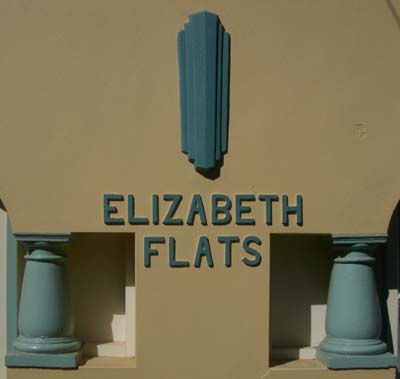 |
Our
new home is the Elizabeth Flats, a 1936 art deco triplex in Katoomba,
the largest town in the Blue Mountains west of Sydney. The address is Flat 1, 21 Warialda Street, Katoomba, NSW Australia 2780. There is a separate web page with more pictures of our new home and its surroundings. |
March 31, 2007: The
end of the 4th month here, which coincided with Earth Hour in Sydney.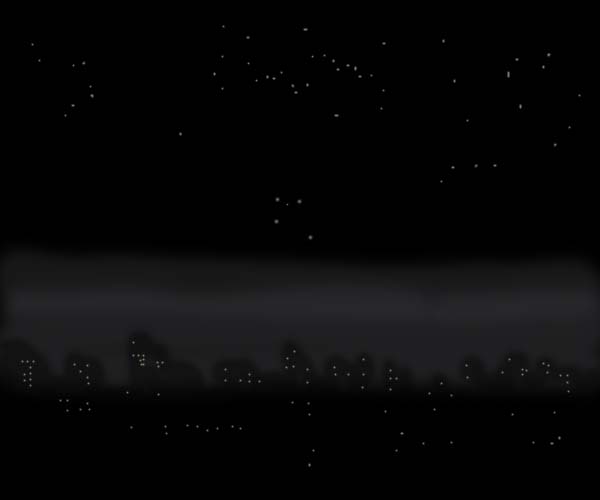 In my imagination, the city looked like this, with the Southern Cross hanging in the sky above. The plan, promoted by the Sydney Morning Herald, was for everyone to turn off all their lights from 7:30-8:30 on March 31st to raise awareness of the issues of climate change; as you can see from the photos on the SMH site,it was a bit brighter there than my imagined cityscape, but quite effective with the Opera House, the bridge, Luna Park and a lot of downtown buildings blacked out. Too many people burned candles, indicating a medieval awareness of the relationship between light and CO2 generation, but that's perhaps nit-picking as the event was intended to be a positive awareness-raiser. Anyway, in Katoomba we managed an Earth 3/4 Hour as we were late starting dinner, and huddled around a hand-cranked LED flashlight -- a marvelous little contraption we bought at a hardware store for $12. |
| March 28, 2007: Back
on December 21, I recorded Christine's comment, based on a few weeks of
shopping and looking around, to the effect that everything that used to
be cheap is now expensive, and vice-versa. For example, I had picked up
volumes 2 and 3 of Rod Stewart's Great American Songbook for $9 each
(that's tax-included), in a city where CDs were $25-$30 even 10 years
ago; Christine had been paying a lot for fruit and vegetables that used
to be almost given away. Meat, too, had become much more expensive. In the paper on the weekend, the chart below appeared: 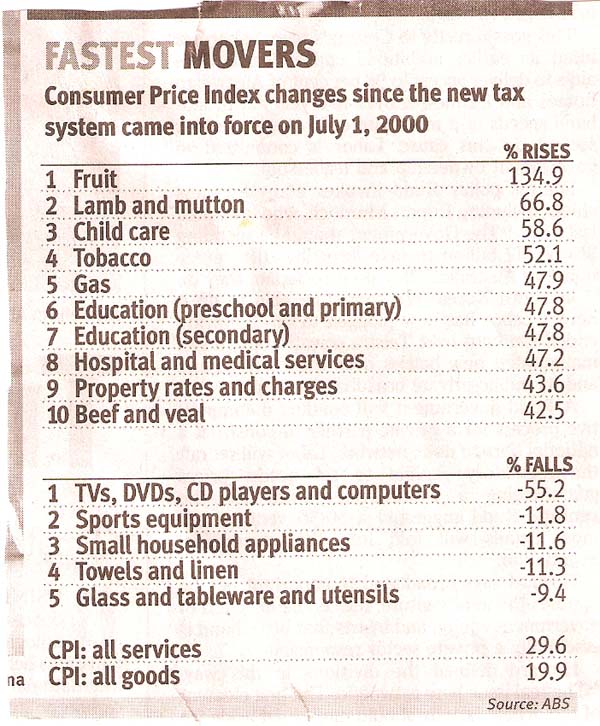 In the "falls"
category, much of
the reason comes down to China and, I suppose, the reduction of import
tariffs. And in the "rises" category, you can blame the drought for a
big part of the increase in food prices. But a month ago, off the back
of a truck parked on the roadside, we did buy from a Queensland farmer
a box of 10 of the most
exquisite mangos I'd ever tasted for $12.
|
March 27, 2007: Autumn
is in the air, with the colours beginning to change in the Blue
Mountains towns.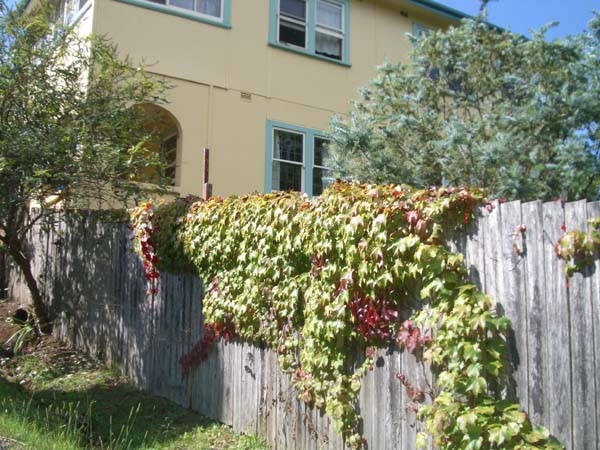 The side fence of our Elizabeth Flats The natural forest,
all eucalypts,
is an unchanging olive green/blue, but exotic vines and trees like oaks
and planes (sycamores) are common in the mountain towns of
Katoomba and Leura, a legacy of the generations of ex-pats who wanted
to put an English cultural stamp onto the landscape.
Autumn. Australians don't say "fall," except to describe what happens on the way home from the pub. We went off daylight savings time on Saturday night, and on cue the temperature dropped drastically after a "southerly change." It had been mid-20s all week in the mountains, and low 30s and sticky hot in Sydney, but we woke up Sunday morning to a temperature of 9 degrees under heavy cloud and drizzle. The high that day was a shocking 12! You realize how solidly Canadian houses are built (especially the house we built at Killara Farm in Langley) when you try to warm up a place like this one. Our efforts to weatherstrip windows and insulate floors have redoubled. The good news is that this wake-up call won't last, and we'll back to the 20s in a day or so. We hope. |
|
March 24, 2007: We
went into Sydney on Friday to see Charles Ross's One
Man Star Wars
show, presented as part of the Cracker comedy festival.
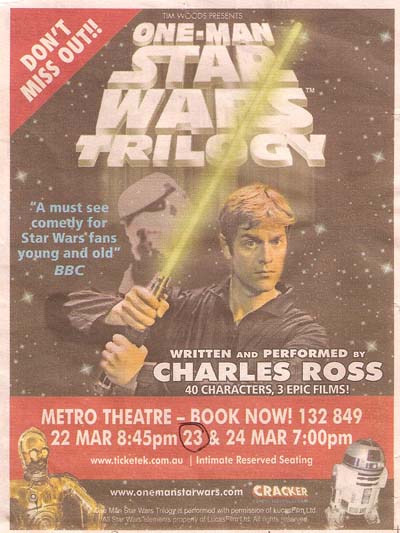 Neither Christine nor I is a great Star Wars (pronounced "stah woahs" here) fan, so why would be go, other than it was niece Madeleine's 19th birthday and she knew Star Wars inside out? We had heard it was a tour de force of wildly funny physical comedy with him performing the voices of 40 characters, plus sound effects. We remembered enough of the first 3 films (known as episodes 4, 5 and 6, apparently), to get the parody. In the theatre, packed with about 700 people, there were dozens who seemed to know every line, and would greet the introduction of a new character or familiar scene with cheering and applause. It was really very funny, with some marvelous ad-libs and one-liners. Okay, but why did we go? Well, Charles Ross is from BC. I met him when his partner Lisa Hebden shared the Grand Forks Art Gallery with me for a show in June, 2006. The three of us, plus some of the members of the touring band Rodney DeCroo and the Killers, stayed in the house of Paul Crawford, the gallery curator, for a few days. Charles's focus was Lisa and her show, and he said nothing about himself or what he did. It was Paul who told me about One Man Star Wars, which by that time had already been touring for four years. Charles had recently returned from a lengthy run in New York. According to Paul, Charles got going as an actor doing street tableaux, in costume, for tourists at Barkerville. Playing Judge Begbie -- that sort of thing. He had grown up in a small town with little else to do than become completely hooked on the Lucas films, which he came to know by heart. He began to imitate the characters, then perform them in front of friends at parties. Everyone liked it so much that he developed it into a show, workshopped it first in Toronto in 2001, and has since toured it all over North America, Britain and, now, Australia. Talk about "following your dream," as it's described on his website. At the end of the show, he did a preview of his One Man Lord of the Rings, with Gollum's voice. So he'll be back in a year or so, with any luck. ***
From Canuck humour to
Aussie.
There was a banner ad on an overpass across the Cumberland highway
which we saw on the way in. Couldn't stop to photograph it as we would
have died in a multiple car-truck crash.
It was a picture of George W., with that rather stunned, perplexed look on his face, sitting at a laptop computer. The caption said: Anyone can manage to find a new home on domain.com.au. And a bumper sticker on the back of a car: If you can read this, I've lost my caravan.* *A travel trailer, right? |
| March 22, 2007: Our
daughter, Sarah Jane, got gazumped at an auction last night. Which
means she got beaten out by other bidders when trying to buy a condo in
Alexandria, an upwardly moving area of South Sydney within walking
distance of Redfern station and her job at the University of Sydney.
The one-bedroom unit ended up selling for about 10% above its reserve
price, which is where she stopped. Two things about real-estate in Australia that take some getting used to, and that I would never trade for the BC system: a lot of properties are auctioned and realtors don't share listings. The auction system is incredibly stressful for the buyer: there is no cooling-off period, no "removals of subjects," you have to have all your inspections and due-diligence done in advance and all your financing in order because if you win it's yours. No counter-offers, no negotiations, no second thoughts. Bang, it's done. It's only in slow markets, like Katoomba's, where the properties are sold by agents with contracts in the way most BC properties go (although the "presentation of offers" that has typified the recent Vancouver boom has auction-like qualities to it). And the point about realtors not sharing listings: you can't get an agent the way you do in Vancouver to look out for you and act on your behalf and shop around with you. Aussie realtors have exclusives, so you end up dealing with a tramful of them when you're looking for a place. And a sports note: the Collingwood school rugby team from North Vancouver played Blue Mountains Grammar School last week, according to our local paper. "Over the last 12 years, we've played nine open games, with both schools having four wins each and a draw," said the BMGS coach. The photo in the paper (below) showed Daniel Barrands of Collingwood being pursued by a horde of striped-shirt Aussies. Canada is a "rugby minnow" which nevertheless "has managed to qualify for every world cup," noted the story. By comparison, Australian rugby goes all the way from school to wildly popular professional leagues. 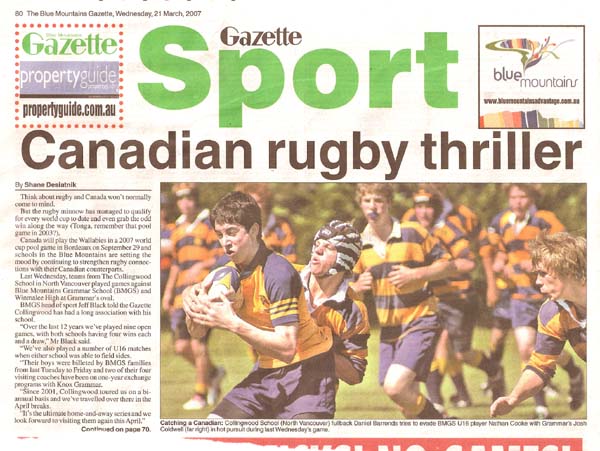 |
March 21, 2007:
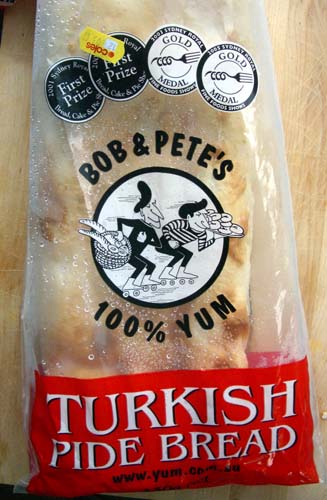 Multiculturalism
hasn't been a big
issue in the current New South Wales election campaign. It's been all
about "leadership," with the sleek, self-satisfied Labour government
machine mounting an American-style attack-ad campaign against the
Coalition leader Peter Debnam. Proving he's worthy of being attacked,
Debnam held an extraordinary news conference last Friday in
which
he effectively conceded defeat, then begged the electorate to lodge a
protest vote for him against Labour. Cleverly, he's now described as
Debnam Walking.
But back to multiculturalism, which ought to have been a big issue given the riots in Cronulla, a southern suburb of Sydney, about 15 months ago. Perhaps they were driven by local issues rather than a general dislike of minorities, but they pointed out a peculiar quality of Australia, which is 92% Caucasian (according to the 2001 census), 7% Asian and 1% aboriginal and "other." Visible minorities, such as the Lebanese in Cronulla, tend to cluster into sharply defined enclaves, what we used to call ghettos, and be almost invisible elsewhere. It has led to a veneer of multiculturalism in Sydney, without the real mixing of neighbourhoods and cultures that you get in, e.g., Canadian cities like Vancouver and Toronto. When Canada gets mentioned at all in the serious Aussie press, it's usually with reference to the success of its multiculturalism and the diversity of peoples. Here, it's more of a "cuisine multiculturalism," with a Thai restaurant on every corner and -- apropos of the pide bread bag photo above -- lots of kebab shops. On Paramatta Road in Stanmore, part of Sydney's inner west, there was a kebab take-away that Christine and I went to a few times, presided over by a guy from eastern Turkey who'd talk your head off while he made your kebab. When he found out we were from Canada, he told us he thought it was the best country in the world to migrate to. "Better than Australia?" we asked. "Australians talk about multiculturalism," he said, "but in their hearts" (he patted his chest) "they don't believe in it for a minute." A bit extreme perhaps, but .... Here in Katoomba, it must be 98% Caucasian, but incredibly diverse politically and culturally, with bare-footed hippies and shaven-headed saffron-robed monks sharing the streets with the blokes and the sheilas. It's said that the electorate here votes half for the Greens, the other half for One Nation (the very right wing, anti-immigration party), which is a joke, as the member of parliament is Labour party. A note on hippie style: the numerous, really long-haired men have dreadlocks, which makes them look like crazed hermits just down from the mountain cave for the day. And further to cuisine, another art shot (below). The ancient tin pan first photographed on March 2, patterned with the remains of roasted soybeans. 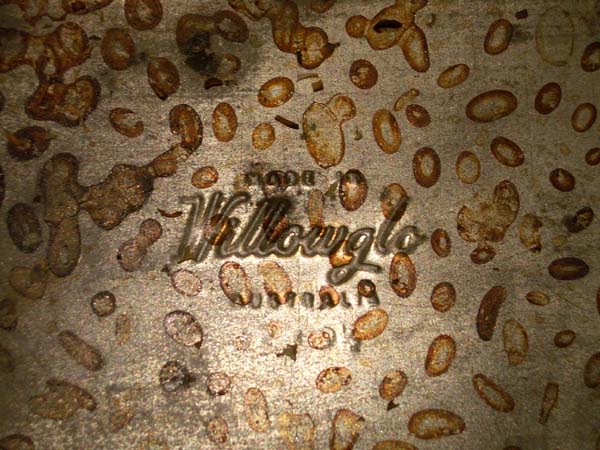 |
March 17, 2007: Because
the spider photo on March 5th attracted so much response, I've made it
a point to photograph, at great personal risk, more examples of garden
and household wildlife!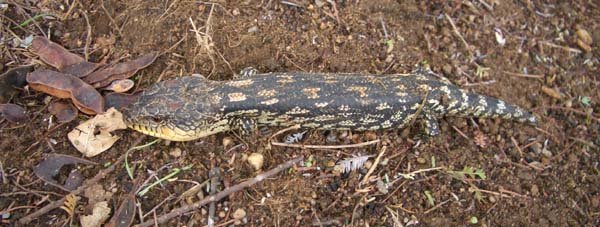 A small salamander in the garden [it's a Bluetongue Lizard, writes Daryl Hutchins!]. They move at a pace slightly faster than a snail, allowing slow-speed takedowns and resulting, we surmise, in the number of empty snail huts in the flower beds. 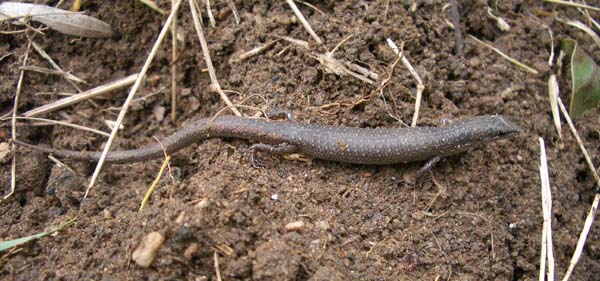 A skink, maybe about 5 cm long. They are really common, and usually zoom out of the way at any movement. They live in the garden beds, along the edge of the sidewalks, in cracks and crannies everywhere, and occasionally wander into the house. Harmless. 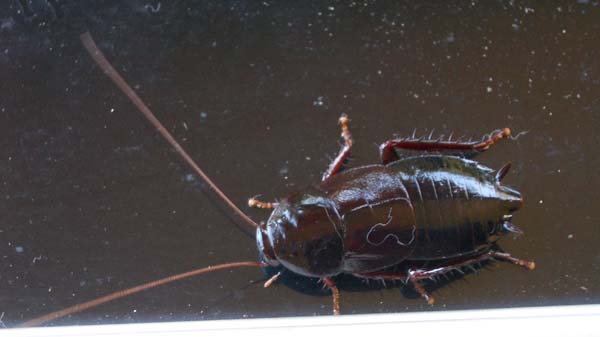 The
great Insect
Photographers of the World unanimously believe that cockroaches are
hard to photograph. They scuttle away usually before you can hit the
"on" button on the camera. We are fortunate here in the Blue Mountains
to have only a few roaches or "cockies," most of relatively modest
size. This one was about 4 cm long in the body, and had been hanging
out underneath the barbeque cover. In Sydney, the cockroaches are
abundant, to say the least, and b - i - g, and every house has a can of
Mortein, a spray insecticide of relatively low toxicity. The Surry
Hills terrace we occupied in December had dozens, many of which were
stunned and staggering, having probably been blasted in a neighbour's
place.
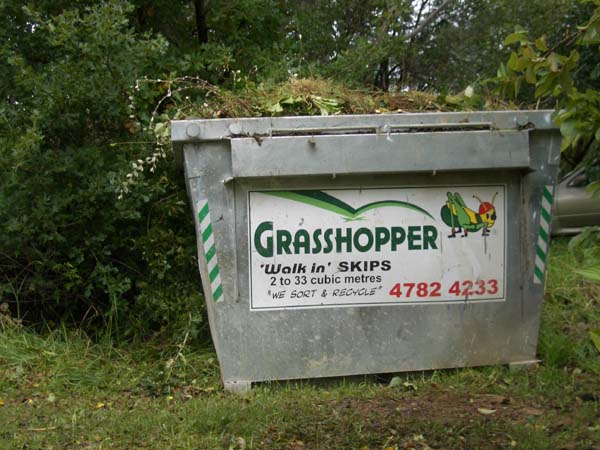 When you're doing a major garden cleanup and weed removal, you rent a skip. This one was 3 cubic metres, about 4 1/2 feet high by 4 feet by 2 feet, I guess. It took a huge amount of garden rubbish, mainly the ivy that was overrunning one side of the place, which compacted down when trampolined repeatedly. |
| March 15, 2007: As part of our quest
to plumb the depths of Aussie culture, we watched a 1990s film called Sirens,
based loosely on artist Norman Lindsay and his milieu. Lindsay
lived near Springwood, a Blue Mountains town not too far from us in
Katoomba. The film was one of a number we've seen, including a
documentary of life in the Outback (Mad
Max), an ancient, clanking miniseries
of doe-eyed Irish convicts suffering under the British jackboot, and an
excellent and too-brief three-parter called Edens Lost.
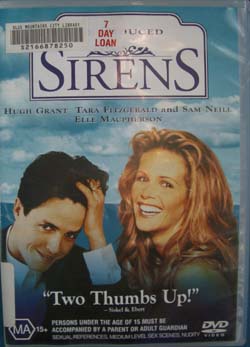 We heard about Sirens when we suggested to Christine's aunt and uncle from Brisbane that we go to the Lindsay Gallery and Museum, which is one of three National Trust properties in the Blue Mountains. We'd been there several years ago; when we went back, we took the tour and heard from the guide how Sirens went way over the top describing Lindsay and the women who lived there and modelled for him as lascivious, amoral libertines. Sam Neill played Lindsay, and a typically mumbling Hugh Grant played the young clergyman who was sent out to tell him that if he didn't stop painting lusty nudes he would be felled by a lightning bolt or trampled by heaven-sent wombats. It was the sensual awakening of Grant's wife, the pale, decorous Tara Fitzgerald, that provided the movie with its oomph (a technical term for emotional suspense). Anyway, it was a slice of Aussiewood, borderline soft-core, with ample opportunities for ample women (and one man) to parade and pose naked. The reality of Lindsay (1879-1969) was much more prosaic, as reality usually is, which is not in any way diminishing him as the most outrageous, rococo artist of the first half of Australia's 20th century. Do look at the website for the National Trust property for a bio and the pictures in the gallery. In his fine art, which was almost exclusively erotic tableaux, he combined Rubens, Watteau and Hieronymous Bosch; his etchings and watercolours are superb and his drawings lively. He was an incredibly deft artist, who could draw as naturally as birds fly. He also wrote and illustrated one of the classic Australian children's books, The Magic Pudding, which has been in print since its publication in 1918, and created a weekly full-page cartoon for The Bulletin newspaper in Sydney. 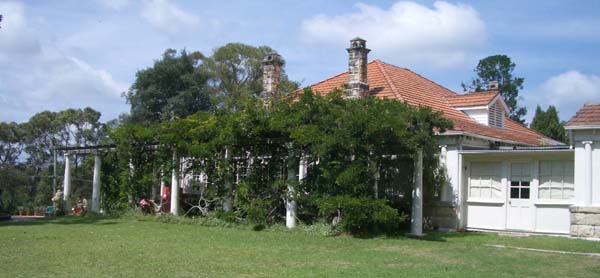 The stone cottage where Lindsay lived for most of his life, now converted into a gallery and museum run by the National Trust of NSW. 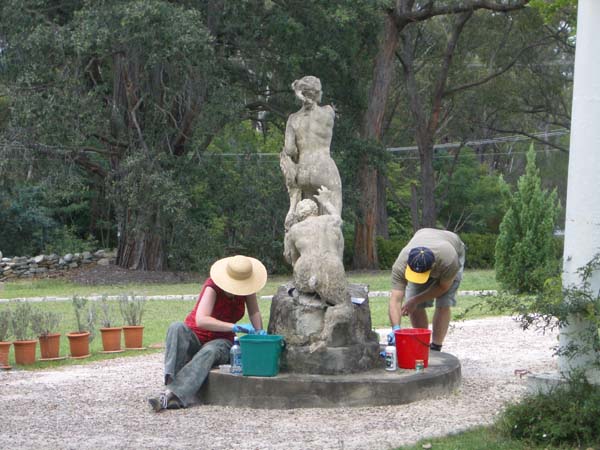 The extensive grounds are dotted with sculptures, all of nudes, which Lindsay described as garden ornaments and created in his spare time. They were all originally concrete, sculpted free-form over iron supports; as they've aged and the concrete has spalled, they need a lot of maintenance. 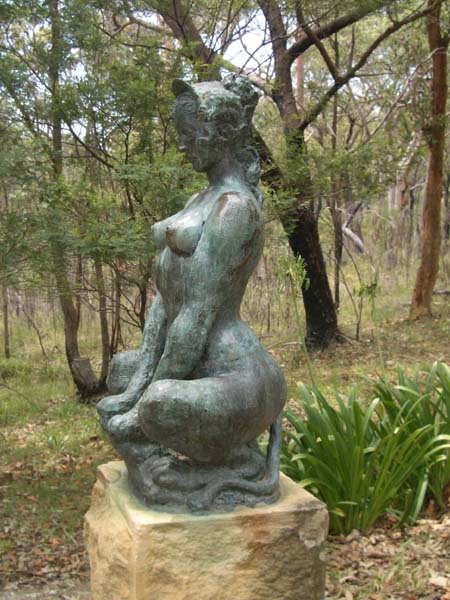 Lindsay's most famous sculpture was his sphinx, modelled on his second wife, Rose. He had the maquette cast as a hood ornament for her car in the 1920s. |
March 12, 2007: 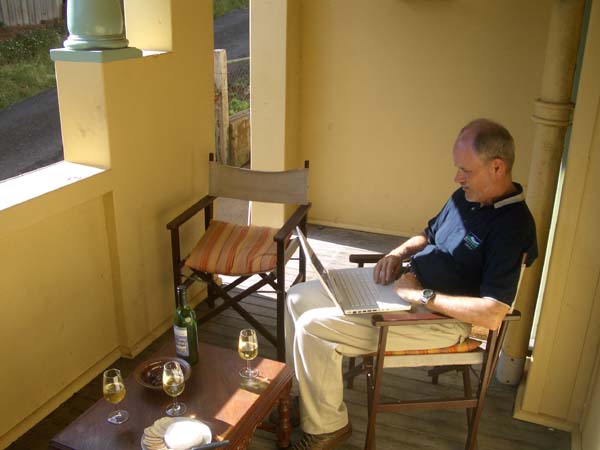 Gordon Price, our first Canadian visitor, hard at work doing email on the porch of Flat 3 on Friday afternoon. Gordon, the former Vancouver councillor and current director of the City Program at SFU, had been on a speaking tour of Australian cities talking about Vancouver and "smart growth" strategies. It
was an interesting weekend being zoned back into Vancouver affairs,
partly due to attending Gordon Price's lecture at Penrith, in which he
talked and showed images of Vancouver, then hearing that Vancouver
Remembered is a finalist for the Duthie
Prize/BC Booksellers Award. Meanwhile, life goes on ....
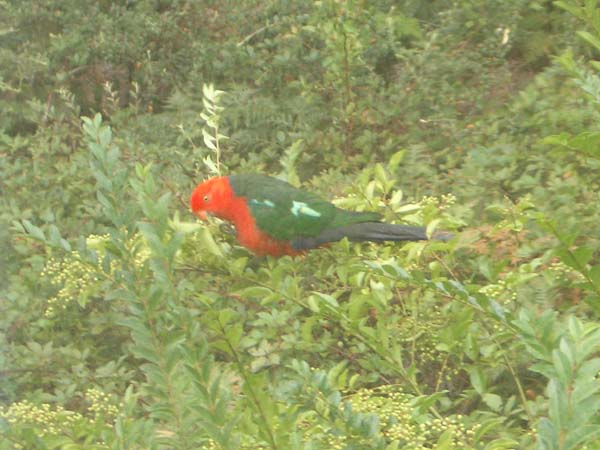 Finally, the King Parrots got close enough to the house that I could photograph them with my toy camera. Both photos are a bit blurry as I had to shoot them through the window of the Sun Room. In the photo below, you can see the brightly coloured male on the left, and the female with her green head on the right. They're eating privet berries, which they will then likely poop into the bush, spreading this invasive plant further into the natural environment. Thus, as Christine writes on her blog, we have our work cut out for ourselves as we try to cut out all the nuisance plants from the back garden. 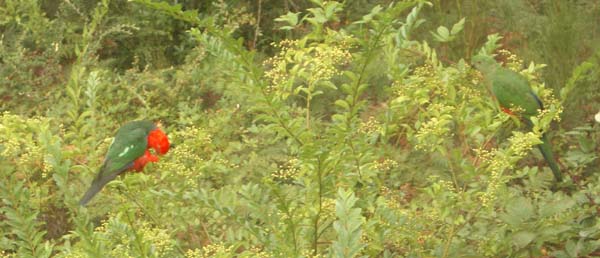 |
| March 7, 2007: Two
reasons to watch the Channel 7 news twice in a row: 1) it was so instructive last night 2) it's too cold to sit outside on the porch (North-shore Sydney's wild storm last night missed us, but it was clouds and only a little sun here today, with a Vancouver-springtime-type high of 16). One of the news headlines was: ALLEGED RORTS. The gist of it was that 3 Liberal backbenchers had their offices raided by police for "rorting their allowances" (tr. ripping off or swindling their expense accounts). Another unique Australianism? |
| March 6, 2007: The
decline of civilisation*, based on a half-hour's news on Channel 7
(which is actually one of only 5 channels): 1) Sydney's first gated community went on the market today, touted as a solution for the crime and security problems of the city's southwest. Experts, citing the North American experience, point out that it will likely increase the sense of separateness between people in a community without doing anything about crime and security. 2) attack ads are a big feature of the New South Wales (state) elections, due later in the month, with the leader of the Coalition being lampooned by the governing Labour party as a business failure in his private life. And former Labour Prime Minister Paul Keating described the current prime minister as a "little desiccated coconut." 3) Bobby's song "A Hard Rain's a-gonna fall" is being used for a Mitsubishi 4WD (that is, SUV) ad. *please note Australian spelling |
March 5, 2007: the
good and the bad of Australia .....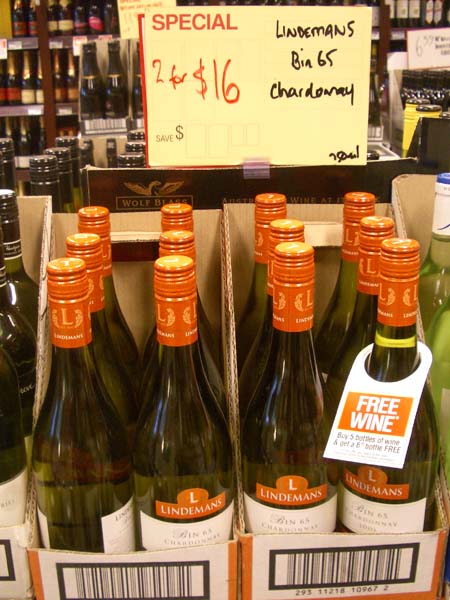 Above: in a land with a lake to drain, every week the local wine shop has various wines on sale. This one would be familiar to practically everyone in Vancouver. You can combine the sales with their loyalty program, so that if you take home 6 bottles they give you a gas discount coupon worth as much as 20 cents a litre. Below: the bad news, you get spiders the size of Buicks coming into the house. Most of them are Huntsmen, a relatively benign type about 6 inches across that nevertheless move v - e - r - y - - q - u - i - c - k - l - y . . . . They must be related somehow to the wolf spiders that used to live in my basement suite in Kitsilano. A helpful household hint: the clear plastic cover over a spool of blank CDs is the perfect size to trap a Huntsman! Slip a magazine or a piece of card under it and you can carry him over to your neighbour's and let him go. 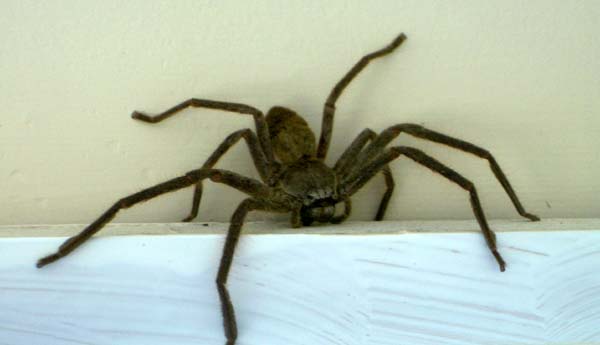 |
| March 4, 2007: As
a break from the constant end-of-the-world-as-we-know-it news of
drought and climate change, Australians have been treated to a
rip-roaring political scandal that is engulfing the prosperous State of
Western Australia and its capital, Perth. Scandals in British Columbia
and Canadian politics rarely measure up to this baby. WA has been riding the mining boom (it truly is "China's quarry") and growing by leaps and bounds for the past decade and more, a period in which a former Labour premier, Brian Burke, has been operating as an influence-peddler and political fixer. Burke was WA premier but was forced to resign in 1994 or thereabouts, and did time in jail for fraud. Upon his release, according to the newspapers, he resumed his "consultancy," the effects of which have caused so far the resignations of 3 key WA Labour Party ministers, the government hanging on to power by its fingernails. Burke, who has been appearing daily before the WA corruption commission, is monitored at his favorite lunching spots -- and even at home -- by "powerful listening devices and concealed cameras" authorized by the commission. A corpulent man with an impassive face, he always wears a dark blue blazer, large dark sunglasses and a white panama hat whose brim touches their top rim. His effect as a fundraiser or a contact for any politician has gone from being "toxic" to "radioactive." The scandal went federal when the new, squeaky clean Labour Party leader of the opposition, Kevin Rudd, was nailed by the John Howard Coalition government for having met with Burke a few times in recent years. "Anyone who deals with Mr. Brian Burke is morally and politically compromised," blustered Coalitiion Treasurer and "head-kicker in chief," Peter Costello. Then, splashed all over the Saturday morning papers, came the revelation that the Coalition's human services minister had met with Burke to discuss a "cultural centre proposal" as part of the redevelopment of a turf club, one of Burke's clients. Last night the minister resigned. ***
On another matter, further to my February 25th entry about the Archibald Prize for portraiture, the winner was announced Saturday under the front page headline, "Why the Archibald winner is BORING." The moody, monochrome portrait of artist Janet Laurence by John Beard was "wistful, absent, boring," according to national arts critic Sebastian Smee. All sneering aside, the critic did make the point of how dependent on "the instantaneous snatch of of photography" the winner and many of the other paintings were. Just to confirm how jaded he is, and what a blood sport art criticism has become, he concluded that ".... It was a rotten field, the worst I can remember." |
March 2, 2007: 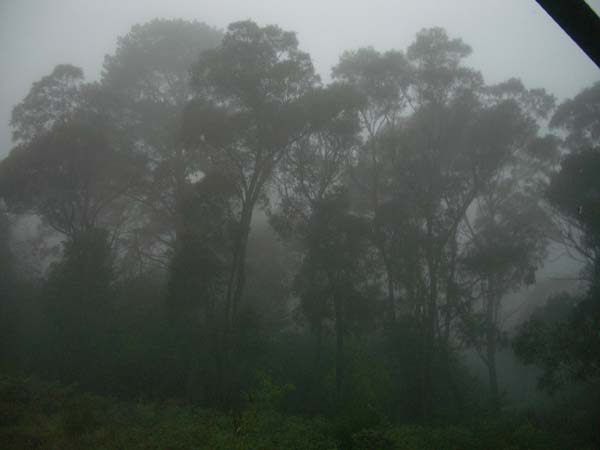 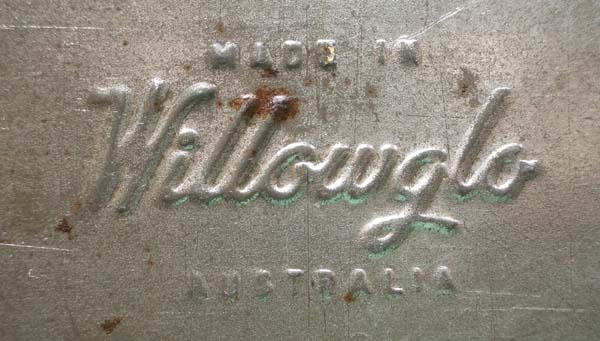 Two studies in grey: view from the kitchen of Flat 3 of the mist that creeps up through the town after a thunderstorm and enshrouds the eucalypts in the gully at the bottom of our garden; and, below, the brand on an old tin tray we found in a junk box in a storage room in the basement, perfect for baking chips, reminscent of a long-ago time when Australia did most of its own manufacturing. Anniversaries always
make me reflect, so the beginning of March, being three months since
our arrival in Sydney after the longest plane journey in memory, is a
time to look back. It is also a cause for celebration, as we've
completed all the formalities and now own the Elizabeth Flats. So the
grand project has moved on to its next phase.
I hear Vancouver has snow again. We got out of there at the end of November, also in snow, wearing sandals, with 2 suitcases each, having over the previous six months sold, given away, recycled and chucked out thousands of pounds of redundant possessions. The last load to go from the farm was mainly metal to be recycled, including our ancient barbecue that dissolved into a shower of rust when it hit the bottom of the bin at the Langley transfer site. Then a local auto parts dealer bought our Mazda pickup truck, shortly before its rusty patches metastasized into terminal cancer. By the time we left our Vancouver apartment, with the car sold to a young Israeli architect, we were as free of responsibilities as we'd been in more than 30 years. But the Singapore Airlines plane sat on the tarmac in Vancouver for several hours waiting to be de-iced. As the crew had been on duty too long to then make the 11-hour flight to Seoul, we were pulled off and sent by bus to the Meridian Hotel on Burrard, fed a dish of sad spaghetti, then awakened at 5 for a caky muffin and a bus trip through the darkened, icy streets back to YVR. The plane then waited another 2 hours before leaving for Seoul. After what seemed like an eternity, we made it to Singapore at nearly midnight in some very foreign time zone, slept for 6 hours, returned to the airport and waited an extra few hours for the delayed connector plane. It was late on December 1, on a humid evening with lightning crackling in the sky, that we finally emerged from customs and quarantine check on Aussie soil. The key to mobility at 18 was to have a half-empty backpack; at 22 it was to own only enough stuff to furnish a VW bus.* At our stage of life, we discovered, the key was to own just what would fit into a 20-foot shipping container. We had pared down our worldly goods from about 8,500 pounds to 6,500, most of which seemed to be books, and bade them farewell from the farm to a storage depot on River Road behind the dyke in Delta, hopefully not on the ground floor. I've made it sound rather easy, but in fact it was a real catharsis, undertaken gleefully by me, less so by Christine. I was determined not to ship and store unfinishable projects or drag along things I knew I would have to dispose of later. So my late aunt Ruby's papers and chattels had to be ruthlessly triaged, a folder of my unwanted watercolours became confetti after some enthusiastic ripping, and unworthy oil paintings succumbed to jumping and sawing. Old silkscreen frames that I had moved from Kitsilano to Kerrisdale in 1983, not used, moved them again to the farm in 1993, still not used, finally went to the dump. It was an instructive exercise in self-management -- a variation on the mid-life crisis which usually involves acquiring more stuff like sports cars or huge TVs. Someone we met here recently suggested that the move would be easy for us, especially for Christine as she would be going home. But, she said, she'd been gone way too long from Australia for it to seem like home to her. * A former editor of a VW bus journal in Pennsylvania, Tom Brouillette, is assembling a book of stories that will probably include some of my experiments, alluded to on the Travel portion of this site, a good example of my unfinishable projects. He was involved with the NEATO bus journal, as I recall. |